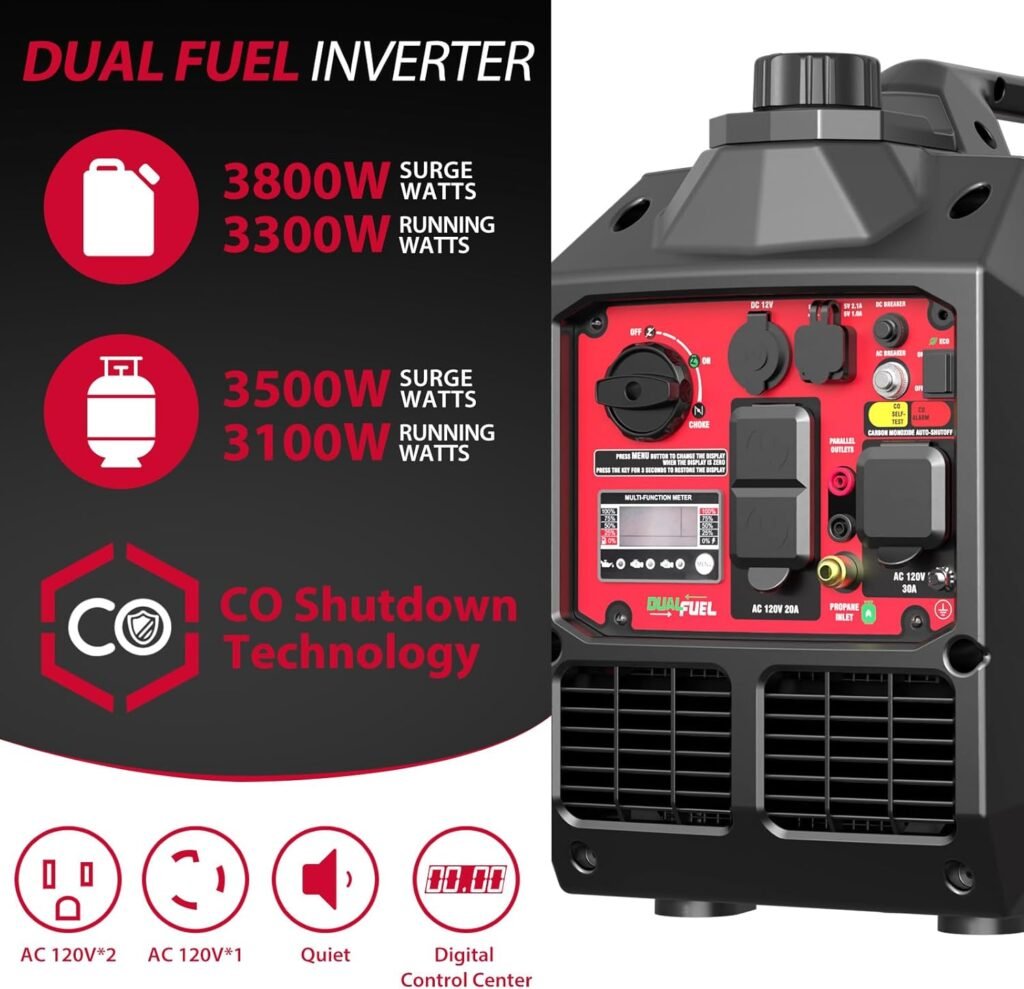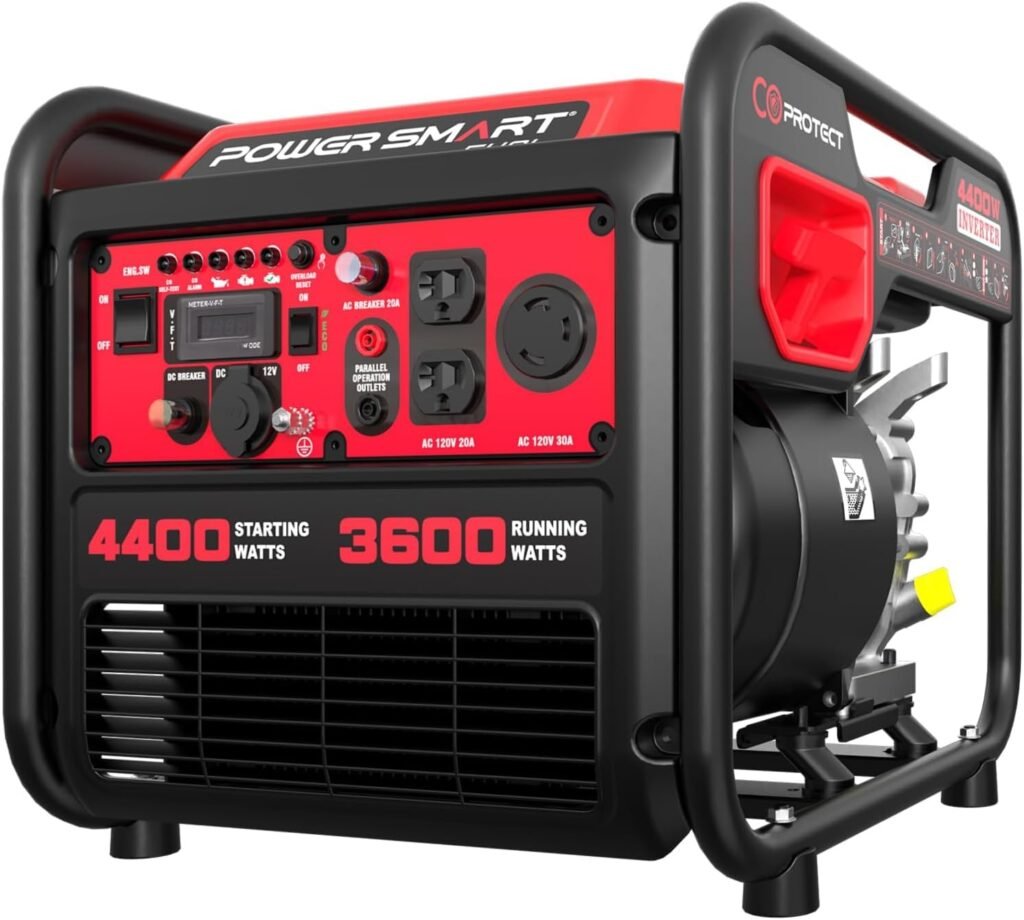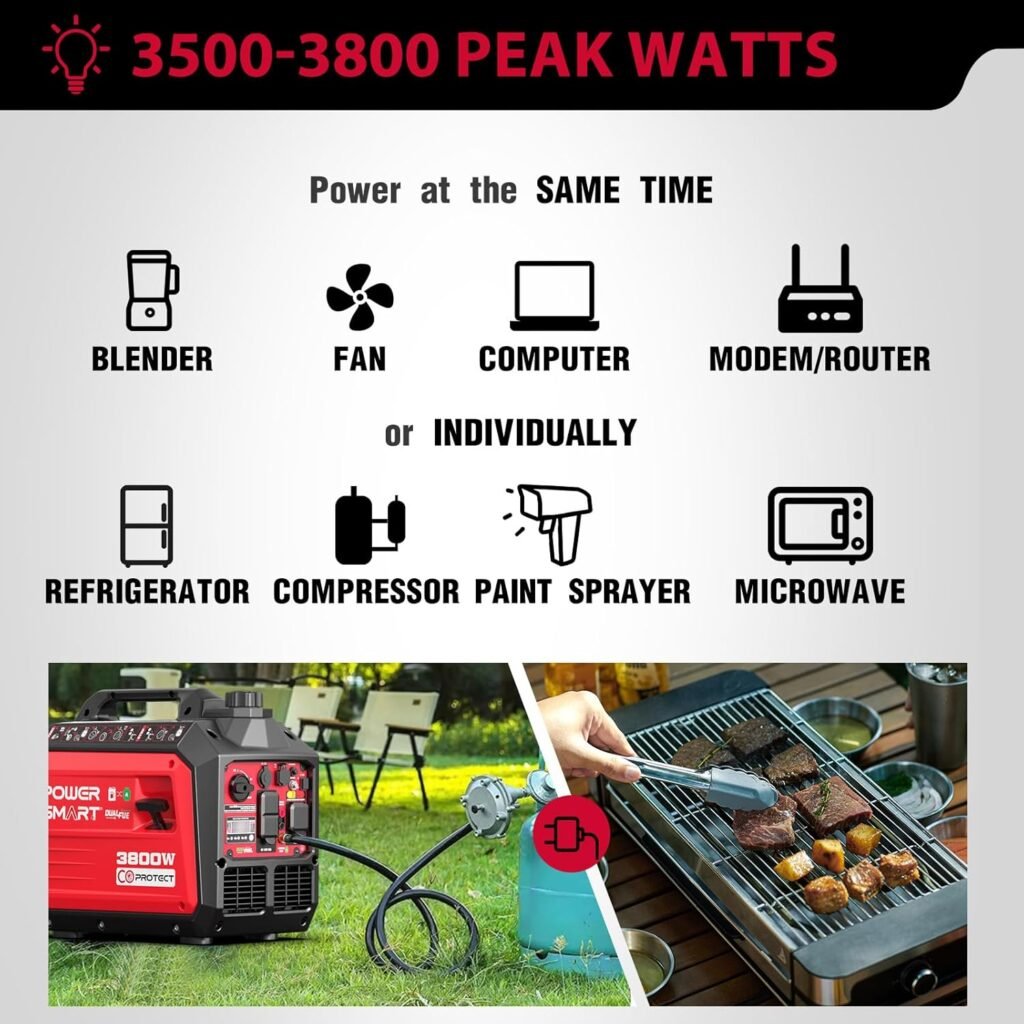
?Is this the 4400-watt portable inverter generator the dependable, quiet, and safe power solution we’ve been looking for?
Our quick take on the 4400-Watt Portable Inverter Generator, PowerSmart Gas Powered, CO-Sensor, Lightweight & Quiet for Home Use and Emergency Backup, Camping, EPA Compliant
We like to start with a straightforward verdict: this generator aims to balance higher output with portability and safety features that matter for home use, camping, and emergency backup. It’s built around a 223cc 4-stroke gas engine and comes with inverter technology, so we get higher starting watts when we need to start motors and reasonably clean power for sensitive electronics when running at rated load.
We’ll walk through its strengths and limitations in detail so we can figure out whether it fits our specific needs. We’ll cover specs, runtime, noise, portability, safety, and real-world scenarios where this unit either shines or falls short.
Key specifications at a glance
Below is a compact breakdown of the most important specs we want to reference throughout the review. This helps us keep the numbers in mind when evaluating performance, runtime, and portability.
| Specification | Detail |
|---|---|
| Product Name | 4400-Watt Portable Inverter Generator, PowerSmart Gas Powered, CO-Sensor, Lightweight & Quiet for Home Use and Emergency Backup, Camping, EPA Compliant |
| Starting Wattage | 4400 W |
| Rated Wattage | 3600 W |
| Engine | 223cc 4-stroke gas engine (EPA compliant) |
| Fuel Tank Capacity | 1.6 gallons |
| Runtime | Up to 11 hours @ 25% load |
| Sound Level | 76 dB @ 23 ft @ 25% load |
| Weight | 61.29 lbs |
| Dimensions | 19.3 x 16.9 x 16.5 inches |
| Safety Features | CO sensor, low oil shutoff, overload protection |
| Compliance | EPA compliant |
We appreciate having the concrete numbers in one place because they make it easier to judge whether the unit meets our requirements for runtime, portability, and power. The combination of starting and rated wattage is especially useful when sizing for multiple appliances.
Performance and power output
We look first at raw power because that’s what determines what appliances and tools we can run. With a peak (starting) wattage of 4400 W and a continuous rated output of 3600 W, this generator can start and run many household loads. For instance, it should be capable of handling a medium-sized refrigerator plus several lights and small devices simultaneously, and it can start motor-type loads such as sump pumps or window air conditioners within reason.
The inverter component is important: inverter generators typically provide cleaner, more stable power compared to conventional generators. That means we can confidently power sensitive electronics—laptops, phones, TVs—without worrying about voltage spikes that could damage them. The 3600 W rated output is a solid figure for a portable unit; it gives us flexibility without the bulk and fuel consumption of larger standby generators.
We do want to note that while starting watts are generous, continuous loads must remain within the 3600 W rating. If we try to run multiple high-wattage appliances continuously (for example, a large central AC plus other heavy loads), we could trip overload protection. So planning load priorities and staggering startup for motor loads will extend usability and prevent nuisance shutdowns.
How it handles appliances and tools
We’ve seen inverter generators in this power range handle refrigerators, sump pumps, lighting, and power tools well when loads are managed. Small to mid-size RV air conditioners and most power tools used casually at a job site are typically within reach. If we need to run heavy-duty job-site tools at full tilt for extended periods, we should verify specific wattage requirements and consider whether a larger generator would be necessary.
We also keep in mind that appliances with large startup currents—compressor-driven devices—may require that extra starting wattage. The 4400 W peak helps here, but smart sequencing of startup is a good practice to avoid tripping the overload.
Runtime and fuel efficiency
Runtime is a major consideration for emergency backup and camping. With a 1.6-gallon tank and a reported runtime of up to 11 hours at 25% load, this model delivers relatively efficient fuel use for its capacity. That runtime figure is appealing because it implies we won’t need to refuel frequently during a long overnight outage or extended campsite stay when we’re running light.
However, real-world runtime depends heavily on the load we put on it. At higher loads—say 50% to 75%—runtime will drop notably. If we plan to run refrigerators, a few lights, and charge devices, the 11-hour estimate at 25% load is realistic. If we add a heater or multiple heavy loads, we should expect fewer hours and should plan fuel storage accordingly.
Practical tips for maximizing runtime
We’ve found a few practical habits that extend runtime: prioritize essential loads, use energy-efficient LED lighting, and avoid running unnecessary devices. Another useful strategy is to use battery banks or power stations for charging phones and laptops to reduce generator load when possible. Keeping the generator at an efficient steady load rather than allowing it to spike repeatedly helps maintain fuel economy over the long run.
Noise levels and quiet operation
Noise is a frequent concern when choosing a portable generator. This unit is rated at 76 dB at 23 feet when operating at 25% load. In practical terms, 76 dB at that distance is noticeable but much quieter than many traditional portable generators. It’s loud enough to be heard but generally unobtrusive for neighbors during outdoor activities and acceptable for many residential scenarios.
We should remember that perceived loudness increases with load and decreases with distance. At higher loads, noise will rise above the 76 dB measure, and if we position the generator closer to occupied spaces the sound will be more prominent. For camping or noise-sensitive neighborhoods, we recommend placing the unit as far from tents or windows as safety allows and using sound-damping techniques, like orienting the exhaust away from living areas.
Comparing perceived sound levels
To put the sound level into perspective, normal conversation is approximately 60 dB, a busy restaurant is around 70 dB, and city traffic close by can be 80–85 dB. So 76 dB is louder than a typical conversation but not extreme. We find it helpful to measure and consider placement before committing to long runs near sleeping areas.
Portability and physical design
One of the selling points here is portability. At roughly 61.29 lbs and dimensions of 19.3 x 16.9 x 16.5 inches, this generator is compact compared to heavier 4500–5000 W units that can weigh 100 lbs or more. We can comfortably lift or carry this unit short distances if we have a second person to help with loading into a vehicle or placing in a storage area.
The compact footprint makes it easier to store in a garage or trunk without taking up excessive room. It’s not ultralight, but for a unit that provides 3600 W continuous output, the balance of weight and power is reasonable. We appreciate models that combine decent power with manageable weight because that makes them far more flexible for RV trips, camping, and transporting to temporary job sites.
Handling and placement tips
When handling the generator, we recommend using proper lifting technique and, if possible, handling with two people. Store it in a dry, ventilated area and keep it level to avoid fuel system or oil issues. For transport, secure it so it doesn’t tip over—spills and damage are the main risks during transit.
Safety features and EPA compliance
Safety is an area where this generator earns noteworthy points. It includes a carbon monoxide (CO) sensor that can shut the unit down if CO levels become unsafe, which is a crucial feature for any generator intended for use around occupied spaces. This reduces the risk of CO poisoning if placement or ventilation is mistakenly inadequate.
The generator also has low oil shutdown to protect the engine from damage when oil levels are too low, and overload protection to prevent electrical damage when the load exceeds capacity. Additionally, the engine is EPA compliant, meaning emissions are controlled to meet regulatory standards for environmental and public health considerations.
CO sensor and safe operation
We feel strongly that CO detection and automatic shutdown is one of the most valuable safety upgrades on modern portable generators. Even with safe placement practices—never running a generator indoors, never inside garages or enclosed spaces—accidents happen. A built-in CO sensor adds a layer of automatic protection that helps prevent catastrophic outcomes if the unit is too close to living spaces or breathes into structures.
Ease of use and controls
The controls on units like this tend to be straightforward: a fuel valve, choke, recoil or electric start, and an array of outlets. Because this is an inverter generator with a focus on household and recreational use, we expect user-friendly operation and simple control layout that most people can learn quickly.
We also value clear labeling for outlets and control switches, plus accessible maintenance points such as spark plug and oil fill. Simplicity in the control panel reduces the learning curve and lets us deploy the generator quickly during power outages or when setting up camp.
Startup and shutdown routine
A common startup routine works well: check oil and fuel, open fuel valve, set choke if cold, pull recoil or press starter, warm up briefly, and then connect loads. For shutdown: disconnect loads, let the unit cool for a moment under no-load conditions, turn off the engine, and close the fuel valve. Following the manufacturer’s recommended procedure helps extend engine life and reduce maintenance issues.
Maintenance and reliability
Routine maintenance keeps any generator reliable. With a 223cc 4-stroke engine, basic maintenance tasks include regular oil changes, air filter cleaning or replacement, spark plug checks, and periodic fuel system maintenance if the unit sits unused for long stretches.
We recommend performing oil changes after the initial break-in period and then at intervals specified by the manufacturer, or more frequently if the generator is used heavily. Storing with stabilized fuel or draining the tank for extended storage periods reduces carburetor varnish and fuel-related issues. These practices help ensure the generator starts reliably when we need it most.
Longevity considerations
The engine design and EPA compliance suggest the manufacturer has focused on modern emissions and reliability standards. Still, longevity depends on care: regular maintenance, using clean fuel, and avoiding overloading will maximize life. We should also keep sensors and safety systems clean and operational—CO sensors and low oil sensors are critical for safe, reliable use.
Real-world use cases and scenarios
We find value in picturing specific scenarios to judge fit. Here are a few common use cases where this generator performs well:
- Home emergency backup: Great for powering refrigerators, essential lighting, and charging devices during outages. It’s especially practical for short-to-medium length outages when we can refuel as needed.
- Camping and RVing: Compact size and a relatively quiet operation make it suitable for campsites that allow generators. Inverter output protects sensitive electronics inside RVs and campers.
- Light job site use: For moderate tools or charging battery packs at a small job site, this unit offers enough power while staying portable.
- Outdoor events: Powering sound systems, lighting, or small caterer equipment for a few hours is feasible when loads are within the rated capacity.
When it’s not the best fit
We’d avoid relying on this unit as a continuous primary power source for large homes with multiple high-demand appliances running simultaneously—central air conditioning or large electric heaters will likely overwhelm it. For heavy-duty commercial usage or continuous full-load operation, a larger, dedicated standby generator would be more appropriate.
Pros and cons
We like to summarize strengths and weaknesses in a way that helps decision-making quickly. Below we list what we think stands out positively and what trade-offs we should consider.
Pros:
- Strong starting power (4400 W) for motor loads and appliances.
- 3600 W rated output suitable for many household and recreational needs.
- Up to 11 hours runtime at light load with a 1.6-gallon tank.
- Inverter technology provides cleaner power for electronics.
- CO sensor and low oil shutdown add important safety features.
- Relatively compact and portable at about 61.29 lbs.
- EPA compliant engine for lower emissions.
Cons:
- Runtime will drop significantly at higher loads; 11 hours is at 25% load.
- Noise at 76 dB is noticeable under certain conditions; not whisper-quiet.
- Fuel tank is modest; frequent refueling may be needed during heavy use.
- Weight is portable but still may require two people for safe lifting and transport.
We find this mix to be reasonable for a mid-range portable inverter generator: a balance between power and portability with modern safety and emission considerations.
Practical trade-offs to consider
If our priority is absolute silence or the longest possible runtime between refuels, we might look at larger inverter models with bigger tanks or units specifically designed for ultra-low noise. Conversely, if we need raw continuous power beyond 3600 W, we should consider larger, non-inverter portable generators or a permanent standby solution.
Comparison with similar generators
It helps to compare this unit with typical alternatives in the market: smaller inverter generators (e.g., 2000–2500 W), similar mid-range inverter units (3000–4000 W), and larger non-inverter generators (5000+ W). Here’s a concise comparison to help us position the unit.
| Category | Typical Strengths | How Our Unit Compares |
|---|---|---|
| Small inverters (2000–2500 W) | Very quiet, very portable, great for RVs and electronics | Our unit provides significantly more power and longer runtime, but is heavier and a bit louder |
| Mid-range inverters (3000–4000 W) | Good balance of power and portability, inverter benefits | Our 3600 W rated power fits squarely here with strong starting watts (4400 W) and comparable features |
| Larger portables (5000+ W) | Higher continuous power for whole-home or heavy tools | Those models offer more continuous capacity and longer runtimes but are much bulkier and louder; our unit trades some capacity for portability and cleaner inverter output |
This comparison shows that the generator sits in a sweet spot for users who need more than a small inverter but don’t want the bulk of a larger portable generator.
Who should buy this generator?
We think this model is a strong candidate for a range of buyers:
- Homeowners seeking a compact backup for essentials (fridge, lights, sump pump, phone charging).
- RV owners and campers who want stable inverter power for electronics and lighting.
- DIYers or small contractors who need portable power for lighter tools and chargers on short jobs.
- Anyone prioritizing safety features like CO detection and EPA compliance in a portable unit.
If our needs include supplying an entire large home or heavy-duty commercial equipment continuously, we’d recommend looking for more powerful options. For most recreational and emergency purposes, this generator is well-suited.
Situations we’d reconsider its purchase
We wouldn’t recommend this generator for continuous whole-home backup in larger houses where central air, electric range, and multiple large appliances need to run simultaneously. We’d also be cautious if we required ultra-quiet operation for quiet campgrounds or events where noise limits are strict.
Buying tips and accessories we recommend
To get the most from the generator, we recommend a few accessories and habits:
- Fuel stabilizer: If the generator will sit unused for weeks or months, treating fuel or draining the tank helps avoid carburetor problems.
- Oil and maintenance kit: Having spare oil, a funnel, and an air filter on hand makes routine maintenance simpler.
- Heavy-duty extension cords rated for the load and outdoor use: Use appropriately sized cords to avoid voltage drop and overheating.
- Wheel/trolley or lifting strap if frequent transport is needed: The weight is manageable but ergonomic assistance helps.
- Carbon monoxide detector for adjacent living spaces: Even with a built-in CO sensor, having detectors around living spaces is an extra safety layer.
We also advise buying from reputable sellers who offer good warranty support, and to register the product with the manufacturer for faster service and updates.
Final recommendation and verdict
Putting everything together, we find the 4400-Watt Portable Inverter Generator, PowerSmart Gas Powered, CO-Sensor, Lightweight & Quiet for Home Use and Emergency Backup, Camping, EPA Compliant to be a versatile choice for those who need a balance of strong starting power, clean inverter output, and built-in safety features. It’s especially attractive for homeowners, RV users, and campers who want dependable power without the size and maintenance of larger units.
We recommend it for anyone looking for a mid-range portable inverter generator that prioritizes safety and portability. If our use case demands continuous heavy loads or we need the quietest possible operation, we should compare against larger or specialty models before deciding. For most emergency backup and recreational scenarios, we feel this unit offers a compelling mix of performance, runtime, and safety.
Closing practical checklist before buying
- Confirm the total wattage of the appliances you plan to run and ensure combined continuous wattage stays under 3600 W.
- Plan for refueling if you expect to run near or above 50% load frequently.
- Factor in the need for two-person lifts or a transport accessory for moving the generator safely.
- Ensure compliance with local noise ordinances and campsite rules regarding generator use.
We hope this detailed review helps us make an informed decision about whether this generator fits our power needs and lifestyle.
Disclosure: As an Amazon Associate, I earn from qualifying purchases.




